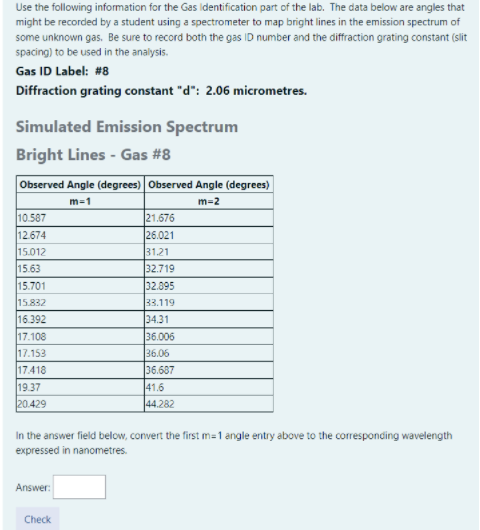Use the following information for the Gas Identification part of the lab. The data below are angles that might be recorded by a student using a spectrometer to map bright lines in the emission spectrum of some unknown gas. Be sure to record both the gas ID number and the diffraction grating constant (slit spacing) to be used in the analysis. In the answer field below, convert the first m=1 angle entry above to the corresponding wavelength expressed in nanometres. PLEASE SHOW THE STEPS FOR HOW TO CALCULATE
Use the following information for the Gas Identification part of the lab. The data below are angles that might be recorded by a student using a spectrometer to map bright lines in the emission spectrum of some unknown gas. Be sure to record both the gas ID number and the diffraction grating constant (slit spacing) to be used in the analysis. In the answer field below, convert the first m=1 angle entry above to the corresponding wavelength expressed in nanometres. PLEASE SHOW THE STEPS FOR HOW TO CALCULATE
University Physics Volume 3
17th Edition
ISBN:9781938168185
Author:William Moebs, Jeff Sanny
Publisher:William Moebs, Jeff Sanny
Chapter4: Diffraction
Section: Chapter Questions
Problem 8CQ: Shown below is the central part of the interference pattern for a pure wavelength of red light...
Related questions
Question
100%
Use the following information for the Gas Identification part of the lab. The data below are angles that might be recorded by a student using a spectrometer to map bright lines in the emission spectrum of some unknown gas. Be sure to record both the gas ID number and the diffraction grating constant (slit spacing) to be used in the analysis.
In the answer field below, convert the first m=1 angle entry above to the corresponding wavelength expressed in nanometres. PLEASE SHOW THE STEPS FOR HOW TO CALCULATE

Transcribed Image Text:Use the following information for the Gas Identification part of the lab. The data below are angles that
might be recorded by a student using a spectrometer to map bright lines in the emission spectrum of
some unknown gas. Be sure to record both the gas ID number and the diffraction grating constant (slit
spacing) to be used in the analysis.
Gas ID Label: #8
Diffraction grating constant "d": 2.06 micrometres.
Simulated Emission Spectrum
Bright Lines - Gas #8
Observed Angle (degrees) Observed Angle (degrees)
m-1
m=2
10.587
21.676
12.674
26.021
15.012
31.21
15.63
32.719
32.095
15.701
15.832
33.119
34.31
16.392
17.108
36.006
17.153
17.418
36.06
36.687
19.37
41.6
20.429
44.282
In the answer field below, convert the first m=1 angle entry above to the corresponding wavelength
expressed in nanometres.
Answer:
Check
Expert Solution
This question has been solved!
Explore an expertly crafted, step-by-step solution for a thorough understanding of key concepts.
This is a popular solution!
Trending now
This is a popular solution!
Step by step
Solved in 2 steps with 1 images

Knowledge Booster
Learn more about
Need a deep-dive on the concept behind this application? Look no further. Learn more about this topic, physics and related others by exploring similar questions and additional content below.Recommended textbooks for you

University Physics Volume 3
Physics
ISBN:
9781938168185
Author:
William Moebs, Jeff Sanny
Publisher:
OpenStax


Physics for Scientists and Engineers: Foundations…
Physics
ISBN:
9781133939146
Author:
Katz, Debora M.
Publisher:
Cengage Learning

University Physics Volume 3
Physics
ISBN:
9781938168185
Author:
William Moebs, Jeff Sanny
Publisher:
OpenStax


Physics for Scientists and Engineers: Foundations…
Physics
ISBN:
9781133939146
Author:
Katz, Debora M.
Publisher:
Cengage Learning

Glencoe Physics: Principles and Problems, Student…
Physics
ISBN:
9780078807213
Author:
Paul W. Zitzewitz
Publisher:
Glencoe/McGraw-Hill